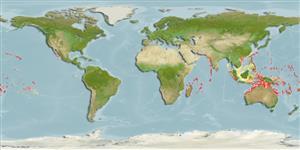Common names from other countries
Teleostei (teleosts) >
Eupercaria/misc (Various families in series Eupercaria) >
Labridae (Wrasses) > Cheilininae
Etymology: Pseudocheilinus: Greek, pseudes = false + Greek, cheilos = lip (Ref. 45335).
Environment: milieu / climate zone / depth range / distribution range
Ecology
Marine; reef-associated; depth range 0 - 50 m (Ref. 1602). Tropical; 28°N - 25°S
Indo-Pacific: East Africa to the Hawaiian and Ducie islands, north to the Yaeyama Island.
Size / Weight / Age
Maturity: Lm ? range ? - ? cm
Max length : 14.0 cm SL male/unsexed; (Ref. 9823)
Inhabits among rubble or live corals of seaward reefs (Ref. 1602), usually in caves and crevices with rich invertebrate growth to at least 40 m depth (Ref. 48636). Benthopelagic (Ref. 58302). Feeds mainly on benthic crustaceans, but also takes small mollusks, echinoids (sea urchins) (Ref. 1602), fish eggs, and crab larvae (Ref. 37816). Minimum depth reported taken from Ref. 128797.
Life cycle and mating behavior
Maturities | Reproduction | Spawnings | Egg(s) | Fecundities | Larvae
Oviparous, distinct pairing during breeding (Ref. 205).
Randall, J.E., 1999. Revision of the Indo-Pacific labrid fishes of the genus Pseudocheilinus, with descriptions of three new species. Indo-Pac. Fish. (28):34 p. (Ref. 33410)
IUCN Red List Status (Ref. 130435)
CITES (Ref. 128078)
Not Evaluated
Threat to humans
Harmless
Human uses
Fisheries: commercial; aquarium: commercial
Tools
Special reports
Download XML
Internet sources
Estimates based on models
Preferred temperature (Ref.
115969): 24.9 - 28.8, mean 27.5 (based on 458 cells).
Phylogenetic diversity index (Ref.
82804): PD
50 = 0.5078 [Uniqueness, from 0.5 = low to 2.0 = high].
Bayesian length-weight: a=0.01585 (0.00707 - 0.03555), b=2.95 (2.76 - 3.14), in cm Total Length, based on LWR estimates for this (Sub)family-body shape (Ref.
93245).
Trophic level (Ref.
69278): 3.4 ±0.39 se; based on food items.
Resilience (Ref.
120179): High, minimum population doubling time less than 15 months (Preliminary K or Fecundity.).
Fishing Vulnerability (Ref.
59153): Low vulnerability (10 of 100).
